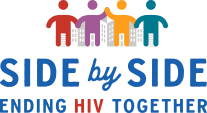What is Harm Reduction?
Harm reduction is the practice of providing services to people who inject drugs to reduce harms associated with drug use, including the sharing of HIV/Hepatitis C. It is guided by principles that stress the acceptance of illicit and licit drug use as a part of life and also requires non-judgemental attitudes in working with people who inject drugs.
Harm Reduction and HIV: Background
Harm reduction as a practice came about in the 1980’s as a more realistic alternative to abstinence-only rehabilitation programs. Once it was discovered through the invention of the rapid HIV antibody test, the HIV epidemic also affected people who inject drugs (PWID) on a large scale. Harm reduction programs (or SSPs) began to focus on HIV testing and reducing the sharing of syringes and other safer injection supplies to decrease the risk of HIV for participants.
Syringe Services Programs (SSPs)
Syringe Services Programs, also known as Syringe Exchange Programs, provide community participants with safer injection equipment, disposal equipment, and referrals to rehabilitation programs that participants can access if and when they’re ready. Many of these programs also provide services such as:
HIV/Hep C testing: SSPs often provide Free rapid Antibody HIV and Hepatitis C testing. Identifying individuals living with HIV and/or Hepatitis C and linking them to care helps decrease the sharing of HIV and Hepatitis C within communities of People Who Inject Drugs (PWID). Some programs may even provide free rapid HIV/Hepatitis C tests that participants can take with them to use at home.
Onsite addiction counselors: Many programs have onsite addiction counselors available for those interested or ready to begin their recovery journey. These counselors can also assist participants with feelings, issues, and stigma surrounding HIV and Hepatitis C diagnosis.
Naloxone distribution and training: Naloxone (brand name: Narcan) is a drug administered when someone is in an active overdose. It can be administered as a nasal spray or with an injection. It helps to block the opioids present in the brain and can reverse the effects of an overdose within minutes. Find Naloxone near you here.
Fentanyl test strips: Fentanyl test strips are paper strips used to test most types of drugs for the presence of fentanyl. This drug is 50 to 100 times more potent than morphine and caused over 56,000 deaths from overdose in 2020. These strips can be found at syringe exchange programs or health departments and may also be purchased. There are no databases to locate these strips for free, but a quick internet search may help you find free fentanyl test strips near you.
SSPs have been found to have many benefits for the participants they serve as well as the surrounding communities. SSPs are estimated to decrease HIV/Hep C incidence by 50% by providing safer injection supplies. SSPs also help bridge the gap between participants and addiction treatment facilities. They lead to participants of SSPs being five times more likely to enter treatment and three times more likely to quit using drugs than others who don’t use these programs. SSPs also prevent overdoses by providing Naloxone and training on how to use it and fentanyl test strips.
PrEP as Harm Reduction
PrEP has quickly become one of the best tools to reduce HIV risk. PrEP is a daily pill (Truvada or Descovy) or bi-monthly injection (Apretude) that is 99% effective in preventing HIV sexually. PrEP is less known as a tool for preventing HIV from being shared intravenously, but it is very effective. Although more research is needed, PrEP is at least 74% effective at preventing HIV from being transmitted through syringe use. At this time, injectable PrEP is not recommended for people at risk of HIV intravenously, and those individuals should use either Truvada or Descovy. Talk to a healthcare provider to determine the best option for you. Find a PrEP provider near you here.
Harm Reduction and Stigma
Harm reduction in practice seeks to end the stigma surrounding drug use and HIV/Hep C. The presence of these programs helps to reduce stigma both in society as well as within the participant. Participants are treated as individuals empowered to make beneficial health choices and will then see themselves less negatively. These results eliminate barriers to these programs and are necessary to make these services more accessible to everyone, which helps end stigma further.
You can help to eliminate the stigma surrounding HIV and harm reduction by:
Talking about HIV and harm reduction with friends and family.
Use person-first language like “People living with HIV” or “People who inject drugs” instead of “Infected with HIV” or “Addict.”
Getting tested for HIV and encouraging friends/family to also get tested.
Stay informed! Know the basics about HIV, HIV prevention, and harm reduction. Learn about SSPs and HIV prevention programs in your community.
Get trained and carry Naloxone! Not only can you save a life, but having it can be a good conversation starter to teach others about the benefits of Naloxone and SSPs.
Get involved! Find your local Harm Reduction Coalition or HIV prevention program and volunteer!
Ending HIV stigma and promoting harm reduction strategies are essential in addressing the HIV/AIDS epidemic. Stigma can prevent people from accessing testing, treatment, and support services, while harm reduction methods can help reduce the spread of HIV among high-risk populations. By providing education and awareness about HIV, promoting non-judgmental attitudes towards those affected by the virus, and implementing harm reduction strategies such as needle exchange programs, we can work towards ending this epidemic. It’s essential to create a supportive environment prioritizing public health over stigmatization to ensure that all individuals receive the care they need regardless of their status or background.






